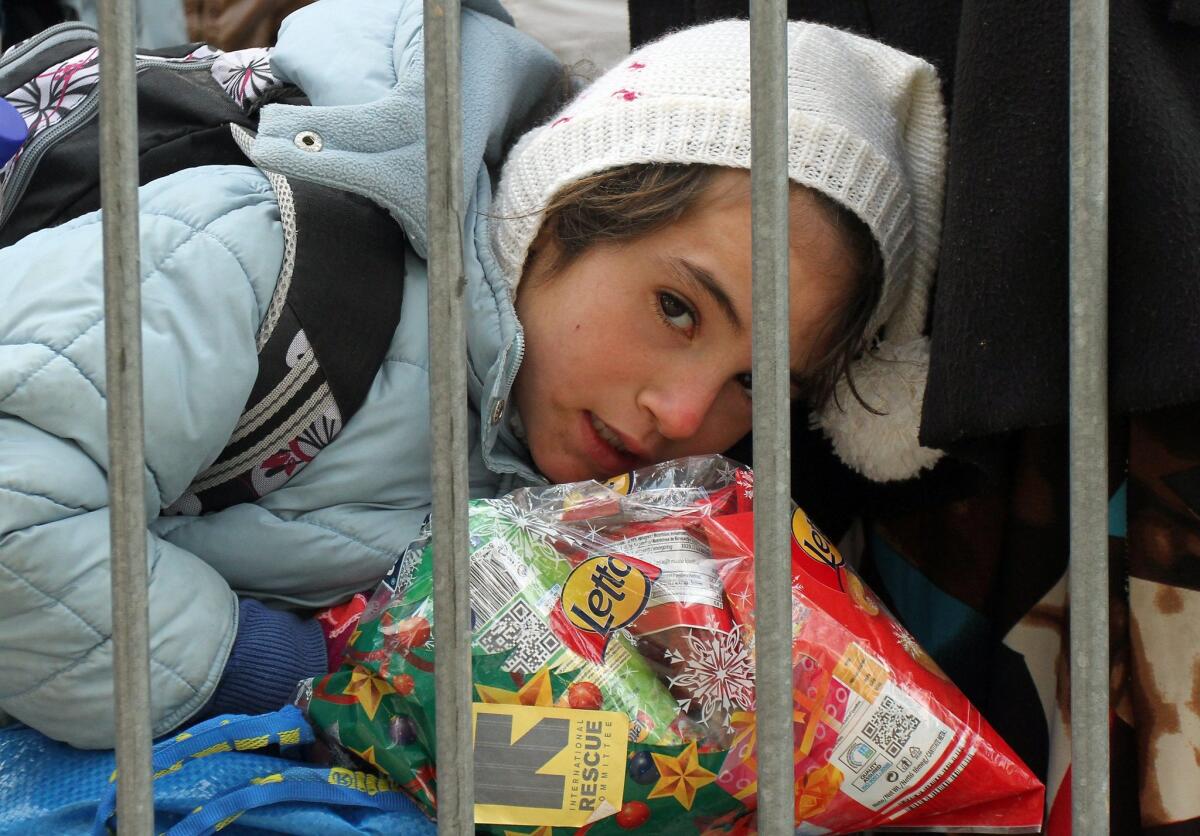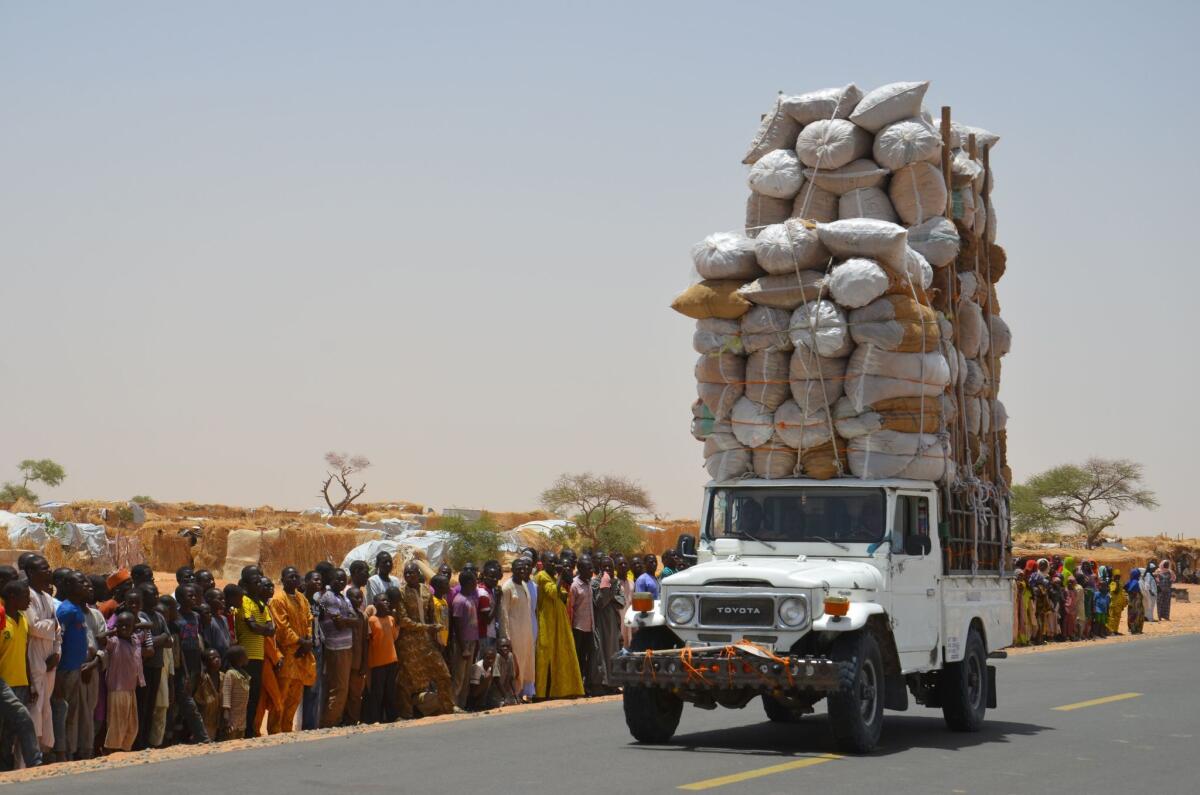Global refugee crisis overwhelms humanitarian aid system and exacerbates its shortcomings
- Share via
War, conflict and persecution have forced about 60 million people worldwide to flee their homes, overwhelming the global humanitarian aid system designed to help them and exposing its shortcomings.
Haphazard organization, inefficient spending and a lack of coordination in delivering aid are among the problems, according to critics who charge that now, more than ever, the structure for helping the world’s most vulnerable people needs to be overhauled.
“It’s definitely the case that the way in which we respond to humanitarian crises needs to be reformed,” said Jodi Nelson, senior vice president for policy and practice for the International Rescue Committee. “It’s not just the humanitarian organizations, it’s the development organizations. It’s really about reforming the entire humanitarian aid system.”
How to better coordinate, fund and organize humanitarian aid are among the topics the World Humanitarian Summit will explore when it opens Monday in Istanbul, Turkey. The two-day event, the first U.N. conference of its kind, was expected to bring together global leaders from government, business, aid organizations, affected communities and youth, among others.
Jens Laerke, deputy spokesman for the U.N. Office for the Coordination of Humanitarian Affairs, or OCHA, said world leaders were expected to commit to advancing action in key areas. These include reaffirming the political and financial pledge to help ensure that 130 million people across 40 countries who are “in need of life-saving assistance and protection” have access to humanitarian aid and protection.
The leaders would also “respond to the widespread call ….for a ‘new way of working’ to address today’s crises, which are increasingly urban, protracted, and complex, leaving millions of people caught in long-term cycles of humanitarian vulnerability and need,” Laerke said in an email.
The problems of the system are endemic, critics charge, not least among them the delivery of aid.
“They have a massive problem with coordination,” said Elizabeth Cullen Dunn, a geographer at Indiana University, Bloomington, who spent 16 months between 2009 and 2103 conducting research in camps for displaced people in the former Soviet republic of Georgia. “There is no one who is in charge. We see a lot of duplication of aid and gaps in delivery.”
“Once they are displaced, [refugees] enter into a system that is extremely chaotic,” added Dunn, who authored a paper on refugee protection and resettlement in the May issue of Science. “There is very little planning involved. It’s very ad hoc.”
Dunn and other advocates for refugees also criticize the length of time that displaced people fleeing conflict and other trauma are generally left to languish in camps. The average is 17 years, Dunn said.
U.N. officials cite a gap in humanitarian funding as exacerbating the challenges to the humanitarian aid system.
“The sheer scale of the global crisis is something we’ve never seen before,” Brian Hansford, a spokesman for United Nations High Commissioner for Refugees, said in a written comments. “But the whole humanitarian system is faced with a critical dilemma because the funds available are not keeping up with the rapidly expanding needs.”

A girl from Syria rests on a bag of humanitarian aid while waiting to be registered at a registration camp in the city of Presevo, Serbia, in December 2015.
According to Laerke, U.N.-led appeals to donors that include governments, intergovernmental institutions and the private sector, have grown from $3.4 billion in 2003 to nearly $21 billion today. “But the gap between the assessed needs and the resources available to meet them is getting wider and wider,” he said.
Theodore Talbot, a senior policy analyst at the Washington-based Center for Global Development, said the funding crisis could be helped through various measures, such as keeping a reservoir of money to help aid agencies respond to on-going problems, as opposed to “ad-hoc funding or having to pass the hat around” for an emergency, Talbot said.
Another way to alleviate the funding shortfall would be to create an insurance contract so that governments could be insured against disasters and get an immediate payout, and not have to depend on donor money, Talbot said.
He has also suggested creating an endowment for refugees.
“Instead of condemning more and more people to a long-term future as aid-dependent refugees, what it we turned the support they would receive from donors over many years into an endowment that would enable them to start a new life in a new country?” Talbot recently wrote in a blog post.
“By capitalizing future humanitarian aid spending and borrowing on capital markets, we could invest in these people,” Talbot added. “This could simultaneously make it more politically palatable for countries to take in people fleeing violence, radically improve those refugees’ lives, and reduce long-run humanitarian costs for donors.”
Humanitarian aid specialists agree that it’s not just about the amount of cash, but how the allotted funds are used.
“There’s no doubt that the need is outpacing the resources available,” said Nelson of the International Rescue Committee. But “it’s not just about needing more aid, it’s about needing better aid.”
Advocates for reforming the humanitarian aid system call for giving a larger share of funding to local and national aid providers, along with greater power to make decisions about how that money is spent. Now, about half a dozen large nongovernmental organizations receive as much as 90% of all funding from the U.N., according to data from aid experts.

An overloaded car travels through the Assaga refugee camp in Diffa in May 2016, close to the Niger-Nigeria border. Chief of Humanitarian Operations of the UN, Stephen O’Brien, has vowed to raise funds at the World Humanitarian Summit for “significant” help to the more than 240,000 refugees displaced by Boko Haram in camps in south-east Niger.
Between 2007 and 2013, only 1.87% of the approximate $17.8 billion received in humanitarian assistance from donor countries went directly to local actors, including national governments, according to research from Oxfam.
“Local actors are often best-placed to respond,” said Shannon Scribner, humanitarian policy manager for Oxfam America. “They understand the culture. They understand the language. They understand what’s going on locally more than people coming in. We need to start trusting them more. We can no longer design a program in another capital, not working with local actors and then use [them] as sub-contractors. It doesn’t work.”
Oxfam is among humanitarian aid providers that encourage making refugees more self-sufficient by giving them direct financial support, an initiative the aid agency implements in countries such as Lebanon and Jordan, where they provide refugees with cash on a debit card.
“It empowers people to make decisions about their spending at a time when they have been stripped of their dignity,” Scribner said. “Their savings are gone. They are living in a country that is not home. It helps to get them the assistance they need.”
More to Read
Sign up for Essential California
The most important California stories and recommendations in your inbox every morning.
You may occasionally receive promotional content from the Los Angeles Times.











